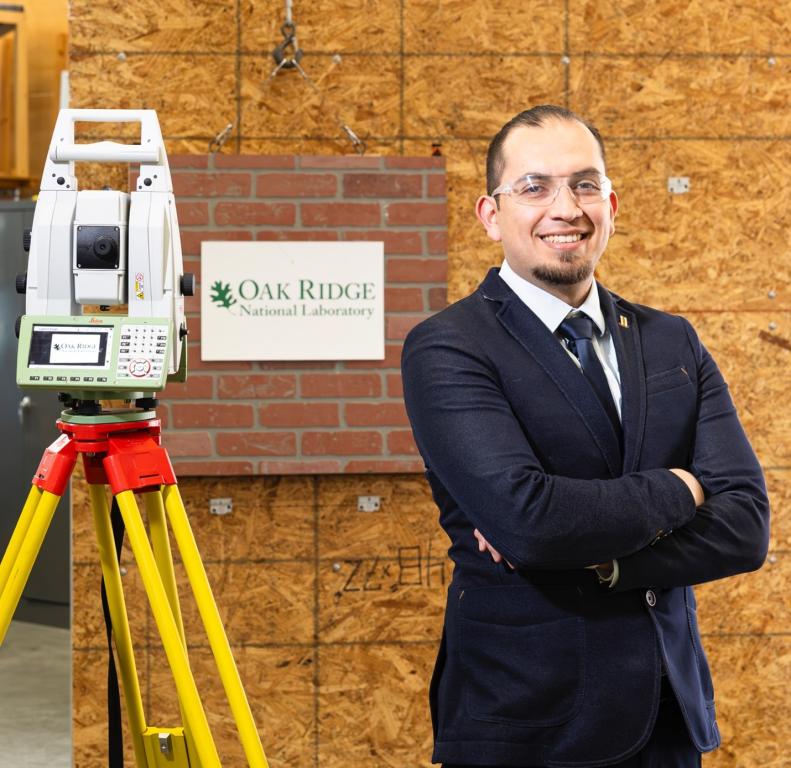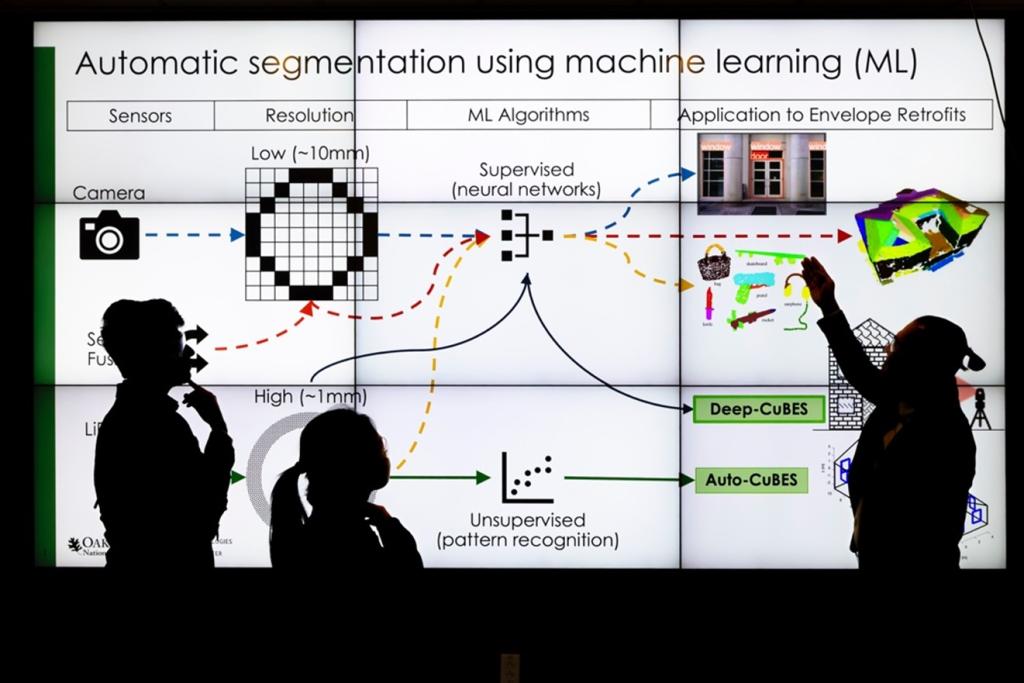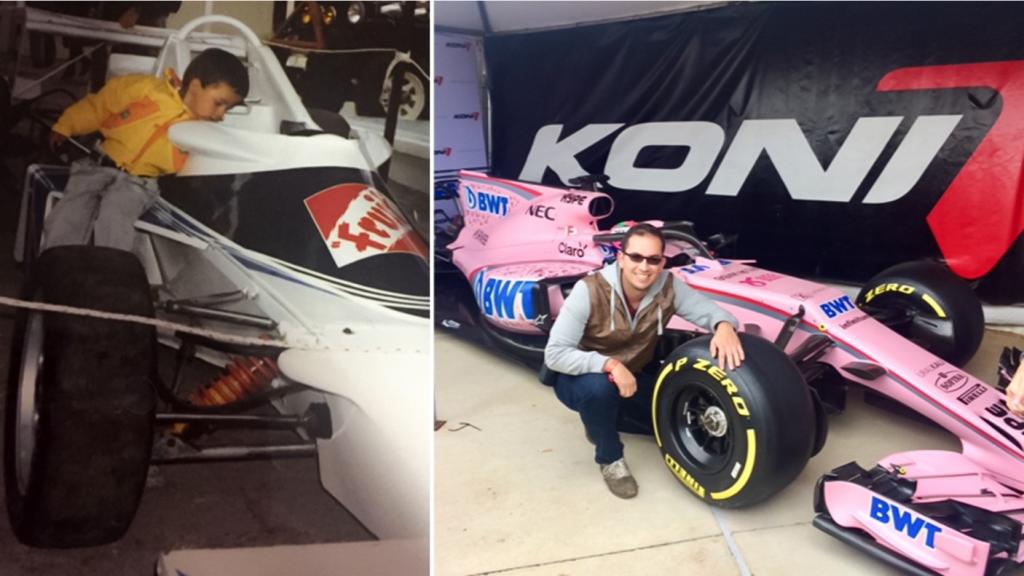
As a mechanical engineer in building envelope materials research at the Department of Energy's Oak Ridge National Laboratory, Bryan Maldonado sees opportunities to apply his scientific expertise virtually everywhere he goes, from coast to coast.
In any neighborhood or downtown district, one is likely to find a building constructed before 1980, when energy efficiency codes requiring thermal insulation were introduced in the United States. While many older dwellings have been modernized and upgraded over time with more energy efficient lighting, air conditioners and heaters, Maldonado said few have improved their exterior walls or envelopes.
"More than 50% of U.S. residential buildings have minimal or no thermal insulation," Maldonado said. "One way to address this is by installing, or retrofitting, prefabricated panels with lower-carbon embodied materials and greater efficiency over the existing envelope. Basically, the solution for making an old building energy-efficient is to put a new, furry coat around it."
A building's envelope includes the outer walls, roof, windows and doors and protects from external elements such as weather, temperature variations and moisture. By serving as a tight barrier, the envelope ensures the environment is comfortable for the occupant and reduces heating and cooling costs. Improving the thermal insulation of buildings is a boost for the environment, too. Energy lost through the envelope accounts for 70% of the carbon dioxide emissions generated locally by homes. These emissions are a primary source of greenhouse gases, or GHGs, which contribute to global climate change.
The Department of Energy's national blueprint for the buildings sector aims to reduce GHGs from buildings 65% by 2035 and 90% by 2050, and to do so equitably to benefit all communities. Achieving these goals, however, requires accelerating the rate of building-envelope retrofits.

Revving up to retrofitting
Maldonado has a vision for using automation to speed up and improve the envelope retrofit process to reach the GHG reduction goals. As an expert in understanding how complex systems operate, he's using machine learning methods to control the process and ultimately optimize performance. However, just a few years ago, Maldonado worked to improve engines in vehicles, not envelopes in buildings.
Growing up in Ecuador, the youngest child and only son of an accountant dad who loved Formula One racing, Maldonado developed an interest in fast cars and the engines that powered them.
"The Formula One races are fun, but the cool thing about this type of sport is the engineering behind it - the entire team that works on the car and all the preparation and all the aerodynamics," he said. "I was curious about how things work under the hood."
Maldonado said it wasn't until high school that he realized his curiosity for mechanics also translated to math and engineering, which he chose as the concentration at his secondary school. His teachers encouraged him to use those gifts to see the world.
"I took my first trip out of Ecuador to Brazil to an international math competition," Maldonado added. "I didn't win, but that gave me the confidence I needed to continue my education in mathematics."
After completing undergraduate degrees in mechanical engineering and mathematics, Maldonado made another trip out of the country, participating in a summer work and travel program while taking college math courses to experience life and school in the United States. He planned to concentrate on the applied side of science, focusing on topics at the intersection of math and engineering, and relocated to finish his master's and doctoral degrees in mechanical engineering at the University of Michigan in Ann Arbor. He's since remained in the U.S., except for a summer stint as a research assistant in Geneva, Switzerland, working for the European Organization for Nuclear Research, commonly known as CERN.
The engine connection
It was a chance encounter that led to Maldonado finding his way to ORNL in 2020, first as an engine technologies researcher and later transitioning to building technologies in 2021.
"I connected with ORNL while interning at Argonne National Laboratory. I met one of the fuels and engines researchers, Brian Kaul, at a national labs conference," Maldonado said. "I realized after his presentation that we were both working on complementary projects, and I had even cited Brian's work unknowingly in one of my research papers."

Maldonado and Kaul were working on how to make internal combustion engines in cars and trucks more efficient through controls. However, they kept encountering the same obstacle.
"When you start optimizing systems, you start pushing things to the limit. We found this very particular limit in combustion where, as fuel consumption decreases and everything is running normally, there is a sudden change in combustion stability, and everything goes nuts, and errors amplify fuel consumption," Maldonado said. "You have this behavior that we didn't understand and most of the car manufacturers said, 'we're just going to stop here and we're not going to keep optimizing,' but I wanted to keep going, and so did ORNL."
Maldonado accelerated his doctoral work to come to Oak Ridge, completing his degree six months ahead of schedule. When he finally arrived at the lab, he and Kaul quickly ramped up their research to understand what triggered the engine's chaotic combustion behavior.
"ORNL knew the combustion science, I knew the control methods, so we moved forward with developing a mathematical model that explains what happens when combustion reaches a certain limit," Maldonado said. "With this mathematical basis and the controls we developed, you can leverage these patterns to optimize the engine."
The work eventually led to a patent, several papers, a book chapter in Artificial Intelligence and Data-Driven Optimization of Internal Combustion Engines, and a pivot to buildings research.

PATH forward
When ORNL's buildings researchers were presented with the task of helping the U.S. rapidly decarbonize buildings, Maldonado was offered the opportunity to help figure out the process for doing so.
"I didn't know a lot about how buildings functioned but Diana Hun, who leads building envelopes research at ORNL, had this vision for how to develop and use tools, advanced sensors, new materials and new processes to transform the retrofitting process," he said. "She gave me the high-level concept, but working in this space was going to be completely out of my comfort zone. Looking back now, that was probably one of the best moves of my career."
Maldonado joined Hun's team in 2021 and began working to develop the real-time building evaluator tool that uses ORNL-created algorithms to compare the location of prefabricated panels during installation with a digital twin or virtual model. The twin, generated in minutes using a 3D scanner, provides one-eighth of an inch accuracy for prefabricated component design and installation. An autonomous robotic tracker then generates real-time positioning data and instructions for installers to minimize errors and expedite installation.
Maldonado and other researchers will be using the real-time evaluator in the field soon as ORNL deploys it to guide exterior wall retrofits in a low-income housing development in Knoxville, Tennessee. While the evaluator tool is crucial to automating retrofitting, Maldonado said it's part of an overall process he's termed PATH, or Pipeline for Affordable, energy-efficient, and Time-saving Housing retrofits. He estimates that PATH will accelerate the retrofit process by fivefold.
"We've developed the sensor technology and the algorithms for control and automation, but what's missing is the integration and optimization so that the entire retrofit process is fully automated," he said.
Maldonado's vision begins with a one-stop software solution to monitor the process, paired with the real-time evaluator tool to optimize the rate of installation, and ends with a slim robotic crane or cable-driven parallel robot that can be installed in construction sites and accurately controlled from a safe distance.
"Right now, we're at the stage of designing and assembling the robotic crane, but much testing has to happen in the lab," Maldonado added. "Ultimately, the goal is to design a flexible platform that can be used on any construction site."
Maldonado said he pictures using the robotic crane to quickly retrofit high rises in dense areas, like New York, in which it is not feasible to use typical construction equipment.
"It can be automated using computer controls, and with the evaluator tool's precise measurements, it eliminates errors, decreases costs and does so in a safe manner," he said.
Building the next generation
As an early career researcher, Maldonado has decades ahead of him to develop innovations beyond fully automated construction. He's also making sure future generations learn about the impact of math, science and technology professions.
At ORNL, he's the vice president for the Hispanic and Latino Organization for Leadership and Awareness, or HOLA, through which he works with elementary school students to encourage math and science careers. His mentoring efforts were recently recognized with the Hispanic Engineer National Achievements Awards Conference's Most Promising Engineer Award for making significant contributions to raising science, technology, engineering and math education awareness in underserved communities. He also annually serves as a volunteer in the organization of the Tennessee Science Bowl, which is a celebrated academic competition that offers teams of high school students from across the state a chance to match their wits in math and science.
"Mentoring is important, because that's why I'm here, because others showed me how I could make an impact beyond Ecuador," he said. However, Maldonado said there's one accomplishment that's eluded him so far - getting to watch Formula One races at all the 24 circuits in person. "I did make it to the Circuit of the Americas and was able to sit down in a demo car," he said. "That was a big achievement."
UT-Battelle manages ORNL for the Department of Energy's Office of Science, the single largest supporter of basic research in the physical sciences in the United States. The Office of Science is working to address some of the most pressing challenges of our time. For more information visit https://energy.gov/science.






